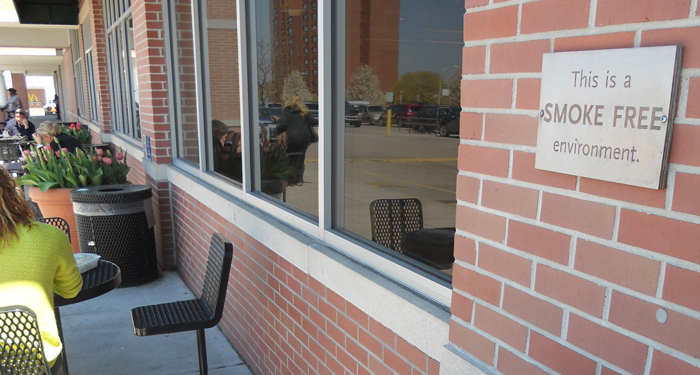
Food tastes better...without a serving of smoke.
The Public Health and Workplace Safety Act of Rhode Island protects patrons and employees from second-hand smoke inside bars and restaurants, but does not extend into outdoor dining areas. Even outside, migrating cigarette smoke can compromise the health and diminish the dining experience of others. According to the U.S. Surgeon General, there is no safe level of second-hand smoke exposure.
Smoke-free outdoor dining policies protect public health. The California Air Resources Board has identified second-hand smoke as a toxic air contaminant, which is an outdoor air pollutant that may cause or contribute to disease and death(1). Outdoor workplaces that permit smoking, such as patio dining areas, can expose restaurant workers and patrons to this toxic air contaminant at levels that exceed the U.S. Environmental Protection Agency limit on fine particulate air pollution(2). Further, researchers have found that someone standing within a few feet of a smoker outdoors may be exposed to similar levels of contaminants as someone exposed to second-hand smoke inside a restaurant or home(3).
Smoke-free outdoor dining policies may even be good for business. In a recent survey conducted by community organizations throughout the state, 88 percent of respondents said they either "liked" or "loved" the idea of smoke-free outdoor dining areas.
Smoke-free outdoor public spaces can also impact beliefs about smoking. Perceptions that smoking is prevalent can make adolescents more susceptible to smoking, so reducing how many people children see smoking is important(4, 5). Eliminating smoking in public outdoor spaces can diminish the perceived popularity of smoking. With 1,300 children under the age of 18 who become new daily smokers each year in Rhode Island, there is still work to be done to reduce the risk of youth smoking.
Check out our "Quick Links" to learn more information.
- 1. California's Clean Air Project, "California Air Resources Board Declares Second Hand Smoke Is a Toxic Air Contaminant," January 26, 2006,
- 2. Americans for Nonsmoker' Rights, "Smokefree Outdoor Air,"
- 3. Global Smokefree Partnership, "The Trend Toward Smokefree Outdoor Areas," December 2009
- 4. Olds RS, Thombs DL, Tomasek JR, "Relations between normative beliefs and initiation intentions toward cigarette, alcohol and marijuana," Journal of Adolescent Health, 2005;37(1):75.
- 5. Primack BA, Switzer GE, Dalton MA, "Improving measurement of normative beliefs involving smoking among adolescents," Archives of Pediatric & Adolescent Medicine, 2007;161(5):434-9.

